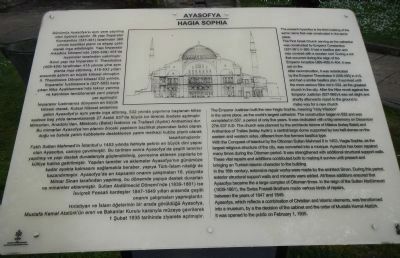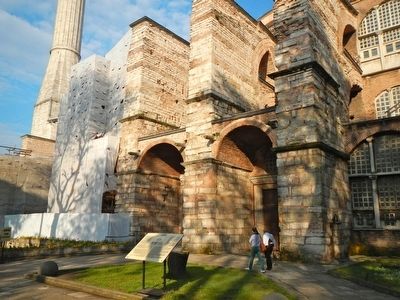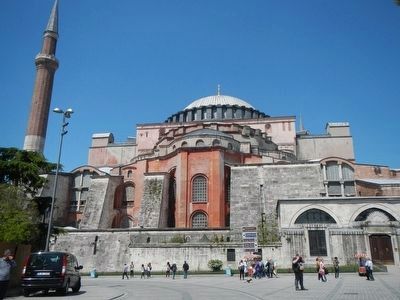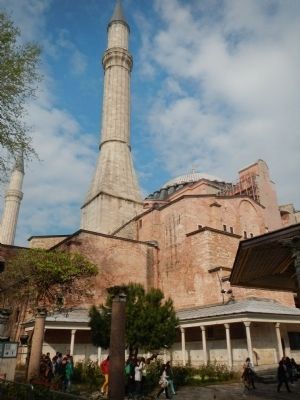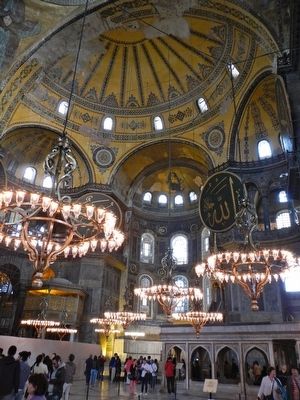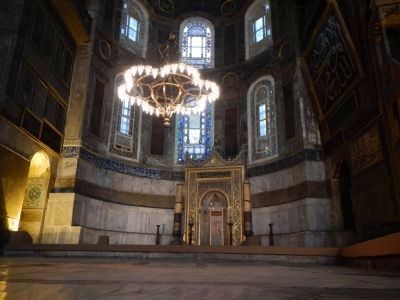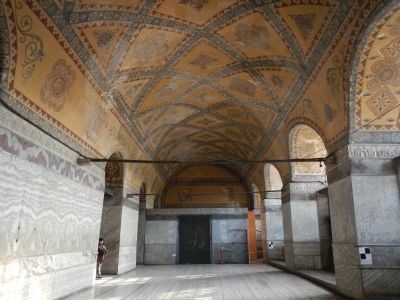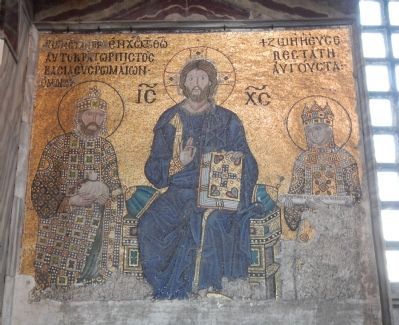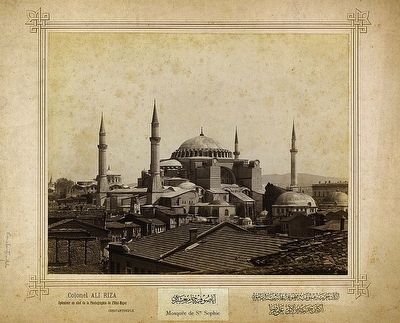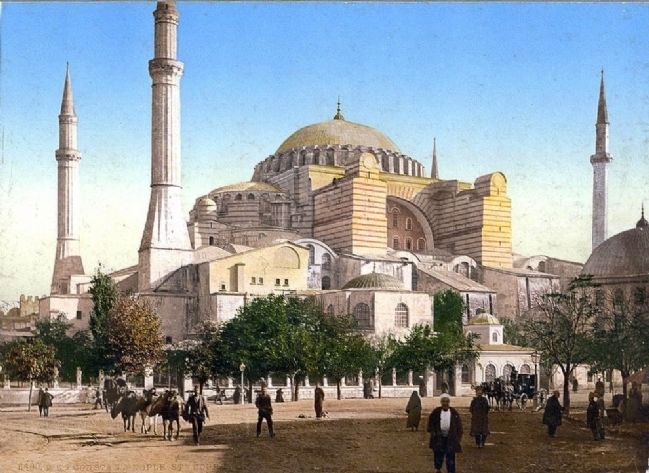Cankurtaran in İstanbul in Fatih, Turkey — West Asia or Southeast Europe
Hagia Sophia
Ayasofya
The present Ayasofya is the third building of the same name that was constructed in the same place.
The First Great Church serving as the cathedral was constructed by Emperor Constantius (337-361) in 360; it had a basilica plan and was covered with a wooden roof. During a riot that occurred during the reign of Emperor Arcadios (365-408) in 404, it was set on fire.
After reconstruction, it was rededicated by the Emperor Theodosios II (408-450) in 415, and had a similar basilica plan. It survived until the more serous Nike riot of 532, as the greatest church in the city. After the Nike revolt against the Emperor Justinian (527-565) it was set alight and shortly afterwards razed to the ground to make way for a new church.
The Emperor Justinian built the new Hagia Sophia, meaning “Holy Wisdom” in the same place, as the world's largest cathedral. The construction began in 532 and was completed in 537, a period of only live years. lt was dedicated with a big ceremony on December 27th 537 A.D. The church was planned by the architects lsidore of Miletus (today Balm) and Anthemios of Tralles (today Aydın): a central large dome supported by two halt-domes on the eastern and western sides, different from the formers basilica type.
With the Conquest of Istanbul by the Ottoman Sultan Mehmed ll in 1453, Hagia Sophia, as the largest religious structure of the city, was converted into a mosque. Ayasofya has been repaired many site many times during the Ottoman period. lt was strengthened with additional structural support walls. These vital repairs and additions contributed both to making it survive until present and bringing an Turkish-lslamic character to the building.
In the 16th century. extensive repair works were made by the architect Sinan. During this period, exterior structural support walls and minarets were added. All these additions ensured that Ayasofya became the a large complex of Ottoman times. In the reign of the Sultan Abdülmecid (1839-1861 ), the Swiss Fossati Brothers made various kinds of repairs, between the years of 1847 and 1849.
Ayasofya, which reflects a combination of Christian and Islamic elements. was transformed into a museum, by a the decision of the cabinet and the order of Mustafa Kemal Atatürk. It was opened to the public on February 1. 1935.
Turkish:
Günümüz Ayasofya'sı aynı yere yapılmış olan üçüncü yapıdır. İlk yapı İmparator Konstantlos (337-361) tarafından 360 yılında bazilikan planlı ve ahşap çatılı olarak inşa ettirilmiştir. Yapı İmparator Arkadios Dönemi'nde (365-408) 404'de isyancılar tarafından yakılmıştır. İkinci yapı ise İmparator ll. Theodosios (408-450) tarafından 415 yılında yine aynı planla inşa ettirilmiş, 415-532 yılları arasında şehrin en büyük kilisesi olmuştur. II. Theodosios Dönemi kilisesi 532 yılında, İmparator İustinianos'a (527-565) karşı çıkan Nika Ayaklanması'nda tekrar yanmış ve kalıntıları temizlenerek yeni yapıya yer açılmıştır.
İmparator İustinianos dünyanın en büyük kilisesi olarak, Kutsal Hikmet anlamına gelen Ayasofya'yi aynı yerde inşa ettirmiş, 532 yılında yapımına başlanan kilise gelen Ayasofya 'yı aynı yerde inşa ettirmiş, 532 yılında yapımına başlanan kilise sadece beş yılda tamamlanarak 27 Aralık 537'de büyük bir törenle ibadete açılmıştır. Mimarları, Anadolu'dan, Miletoslu (Balat) İsidoros ve Trallesli (Aydın) Anthemios'dur. ki yapıların bazilikal planından farklı olarak Bu mimarlar Ayasofya'nın planını önce yapıların bazilikal planından farklı olarak doğu ve batıda yarım kubbelerle desteklenen yarım merkezi kubbe planli olarak tasarlamışlardır.
Fatih Sultan Mehmed'in İstanbul'u 1453 yılında fethiyle şehrin en büyük dini yapısı olan Ayasofya, camiye çevrilmiştir. Bu tarihten sonra Ayasofya'da çeşitli tamirler yapılmış ve yapı destek duvarlarıyla güçlendirilmiş, çevresine eklenen yapılarla bir külliye haline getirilmiştir. Yapılan tamirler ve eklemeler Ayasofya'nın günümüze kadar ayakta kalmasını sağlamakla beraber, yapıya Türk-Islam niteliği de kazandırmıştır. Ayasofya'da en kapsamlı onarım çalışmaları 16. yüzyılda Mimar Sinan tarafından yapılmış, bu dönemde yapıya destek duvarları ve minareler eklenmiştir. Sultan Abdülmecid Dönemi'nde (1839-1861) ise İsviçreli Fossati kardeşler 1847-1849 yılları arasında çeşitli onarım çalışmaları yapmışlardır.
Hıristiyan ve İslam öğelerinin bir arada görüldüğü Ayasofya, Mustafa Kemal Atatürk'ün emri ve Bakanlar Kurulu kararıyla müzeye çevrilerek 1 Şubat 1935 tarihinde ziyarete açılmıştır.
Erected by Kültür ve Turizm Bakanlıǧı.
Topics. This historical marker is listed in this topic list: Churches & Religion. A significant historical month for this entry is February 1974.
Location. 41° 0.527′ N, 28° 58.765′ E. Marker is in İstanbul, in Fatih. It is in Cankurtaran. Marker is on Caferiye Sokak close to Caferiye Sodak, on the right when traveling east. Touch for map. Marker is at or near this postal address: Caferiye Sk 6, İstanbul 34122, Turkey. Touch for directions.
Other nearby markers. At least 8 other markers are within walking distance of this marker. The Remnants of the Theodosian Hagia Sophia (5th Century) (within shouting distance of this marker); The Türbe (Tomb) of Sultan Selim II (within shouting distance of this marker); The Türbe (Tomb) of Sultan Mehmed III (about 90 meters away, measured in a direct line); Million (about 120 meters away); The Basilica Cistern (about 120 meters away); a different marker also named Basilica Cistern (about 120 meters away); The Milion Stone (about 120 meters away); Topkapi Palace (about 180 meters away). Touch for a list and map of all markers in İstanbul.
More about this marker. The museum entrance is from Sultan Ahmed Parki.
Also see . . .
1. Hagia Sophia - Wikipedia. Famous in particular for its massive dome, it is considered the epitome of Byzantine architecture[6] and is said to have "changed the history of architecture". It remained the world's largest cathedral for nearly a thousand years, until Seville Cathedral was completed in 1520. The current building was originally constructed as a church between 532 and 537 on the orders of the Byzantine Emperor Justinian I and was the third Church of the Holy Wisdom to occupy the site, the previous two having both been destroyed by rioters. It was designed by the Greek scientists Isidore of Miletus and Anthemius of Tralles. (Submitted on June 27, 2015, by Barry Swackhamer of Brentwood, California.)
2. History. The Hagia Sofia Museum's history of .The current structure was constructed by Isidoros (Milet) and Anthemios (Tralles), who were renowned architects of their time, by Emperor Justinianoss (527-565) orders. Information from historian Prokopios states that the construction that began on February 23, 532, was completed in a short period of five years and the church was opened to worship with a ceremony on December 27, 537. Resources show that on the opening day of the Hagia Sophia, Emperor Justinianos entered the temple and said, My Lord, thank you for giving me chance to create such a worshipping place, and followed with the words Süleyman, I beat you, referring to Süleymans temple in Jerusalem. (Submitted on August 14, 2015.)
Credits. This page was last revised on February 13, 2023. It was originally submitted on June 27, 2015, by Barry Swackhamer of Brentwood, California. This page has been viewed 527 times since then and 21 times this year. Photos: 1, 2, 3, 4, 5, 6, 7, 8. submitted on June 27, 2015, by Barry Swackhamer of Brentwood, California. 9. submitted on August 14, 2015. 10. submitted on July 22, 2015. • Andrew Ruppenstein was the editor who published this page.
